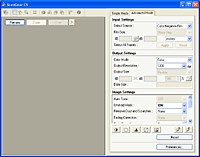Scanning Film (8400F)
| Article ID: ART159938 | | | Date published: 06/09/2015 | | | Date last updated: 08/18/2015 |
Description
Solution
Scanning Film (8400F)
This scanner can scan 35 mm film strips up to 12 frames, 35 mm mounted slides and 120 format films.
| Scanning Films with ScanGear CS in Simple Mode | |||
|
| Scanning Films with ScanGear CS in Advanced Mode | |||
|
 |
* | Only 35 mm color film strips and mounted positive slides can be scanned with the scanner buttons or CanoScan Toolbox. Monochrome films, mounted negative slides and 120 format films cannot be scanned with these methods. |
| * | To scan monochrome films, mounted negative slides and 120 format films, start ScanGear CS from an application program and use the Advanced Mode to scan. See Scanning Films with ScanGear CS in Advanced Mode | |
 |
* | Mounted 120 format films cannot be scanned. |
| * | Do not set positive and negative films in the same Film Guide. | |
| * | The estimated time remaining will display when multiple frames are scanned. The time shown is a rough estimate that will vary according to the computer system environment and scan settings. Moreover, it may not show when a single frame is scanned. | |
| * | If a portion of the film base outside the image or the Film Guide shows in the preview image, select a scan area with the cropping frame before scanning. Including a portion of the film base or the Film Holder in the scan may cause the coloration of the scanned image to be off. |
Scanning Films with ScanGear CS in Simple Mode
To scan 35 mm film strips and slides into an application program, you can start ScanGear CS from within the program.
In the Simple Mode, there are only a few simple procedures.
- Remove the protective sheet from the document cover of the scanner.
- Set the film in the Film Guide, and position the Film Guide on the document glass of the scanner.
Refer to the Quick Start Guide for positioning film.
- Close the document cover.
-
Start ScanGear CS from within the application program.
<PhotoStudio is used in this example>
- Click the [Start] menu and select [(All) Programs], followed by [ArcSoft PhotoStudio 5.5] and [PhotoStudio 5.5].
- Click the [File] menu and select [Acquire].

- Double-click the [PhotoStudio] alias on the desktop or open the [Applications] folder, and double-click the [PhotoStudio] folder, followed by the [PhotoStudio] icon.
- Click the [File] menu and select [Acquire].
The ScanGear CS window will display.
- If ScanGear CS is in the Advanced Mode, click the [Simple Mode] tab to display the Simple Mode window.
- Select the [Select Source].
You can select from the following options:
Negative Film (Color) / Positive Film (Color)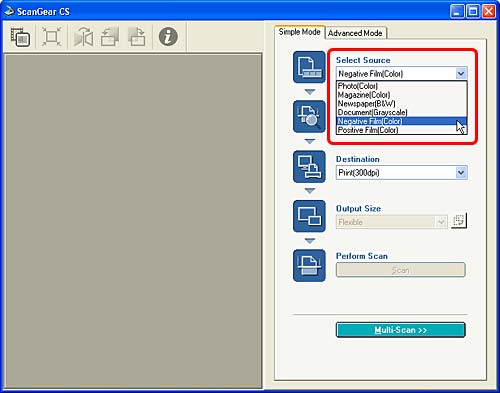
-
Click the [Preview] button.
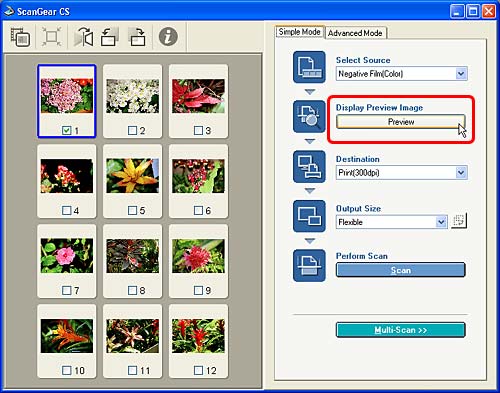
Thumbnails of the frames will display.
- If the previewed image does not display correctly, adjust the position of the film in the Film Guide and click the [Preview] button again.
- Do not open the document cover while a scan is in progress.
- Place a check mark beside the frames you wish to scan.

A check mark automatically appears on the first frame. If you do not need to scan a frame, click the check mark to remove it.
- Select the [Destination].
Select a frame (click it and the blue selection frame displays) and a Destination setting: either Print (300 dpi) or Image display (150 dpi). The Output Size options in the next step will vary according to the Destination setting selected.
 More than one frame cannot be selected (blue selection frame) at the same time.
More than one frame cannot be selected (blue selection frame) at the same time.
-
Select the [Output Size].
You can select from the following options.
If "Print (300dpi)" is selected in step 9 If "Image display (150dpi)" is selected in step 9 

- Selecting Flexible enlarges 35 mm film to the Photo Size (4"x6").
-
Selections Other than Flexible:
- When the Print (300dpi) option is selected, you can set the output size to match standard paper formats. The scan area is enlarged or reduced to fit the output to the specified paper size. You can set your own output sizes with the [Add/Delete] option.
- When you select Image display (150 dpi), you can select the Output Size according to its pixel dimensions (pixels are the picture elements used to display an image on a monitor). Since the pixel dimensions correspond to the dimensions of standard computer displays (monitors), you can use the images as "wallpaper" without adjustment. They also correspond to the dimensions to which digital camera images can be set, allowing you to manage and organize your scanned images along with digital camera images. You can specify the pixel dimensions of customized output sizes with the [Add/Delete] option.
 Only the settings you add with the [Add/Delete] option can be deleted. The preset options cannot be deleted.
Only the settings you add with the [Add/Delete] option can be deleted. The preset options cannot be deleted.
Steps 9 and 10 are conducted on each frame that is scanned.
- Click the [Scan] button.
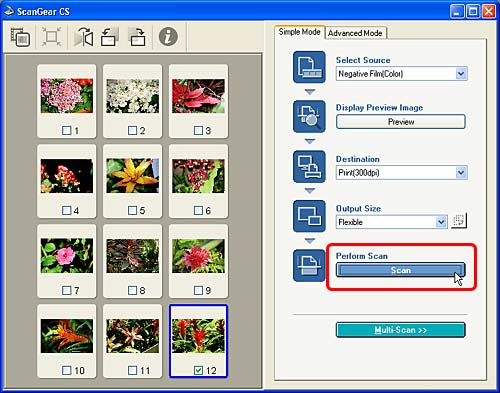
- After the scan is complete, click the close box
 (Windows) or
(Windows) or  (Macintosh) to close ScanGear CS.
(Macintosh) to close ScanGear CS.
The image will display in the application program.
- Save the displayed image.
- After you have finished scanning film, put the protective sheet back on the document cover of the scanner.
 Always replace the protective sheet when you are not scanning film.
Always replace the protective sheet when you are not scanning film.
Scanning Films with ScanGear CS in Advanced Mode
To scan films into an application program, you can start ScanGear CS from within the program.
In the Advanced Mode, you can change the resolution and use various functions to scan, including color correction and filters.
- Remove the protective sheet from the document cover of the scanner.
- Set the film in the Film Guide, and position the Film Guide on the document glass of the scanner.
Refer to the Quick Start Guide for positioning film.
- Close the document cover.
-
Start ScanGear CS from within the application program.
<PhotoStudio is used in this example>
- Click the [Start] menu and select [(All) Programs], followed by [ArcSoft PhotoStudio 5.5] and [PhotoStudio 5.5].
- Click the [File] menu and select [Acquire].

- Double-click the [PhotoStudio] alias on the desktop or open the [Applications] folder, and double-click the [PhotoStudio] folder, followed by the [PhotoStudio] icon.
- Click the [File] menu and select [Acquire].
The ScanGear CS window will display.
- If ScanGear CS is in the Simple Mode, click the [Advanced Mode] tab to display the Advanced Mode window.
- Set the [Select Source] category corresponding to the film.

- Set the [Color Mode] category corresponding to the image you want.
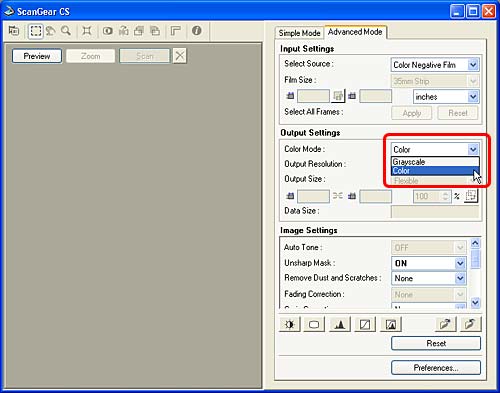
- Click the [Preview] button.
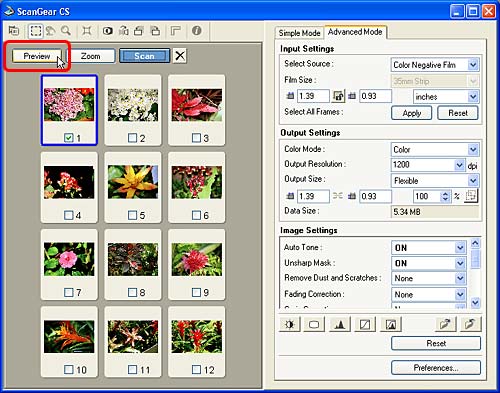
Thumbnails of the frames will display. If the previewed image does not display correctly, adjust the position of the film in the Film Guide and click the [Preview] button again.
If the previewed image does not display correctly, adjust the position of the film in the Film Guide and click the [Preview] button again.
- Place a check mark beside the frames you wish to scan.
A check mark automatically appears on the first frame. If you do not need to scan a frame, click the check mark to remove it.
-
Select an [Output Size].
You must select the Output Size for each individual frame that you are scanning by clicking it to display the blue selection frame and then selecting the Output Size.
This procedure is not required when you scan each frame with the Flexible option.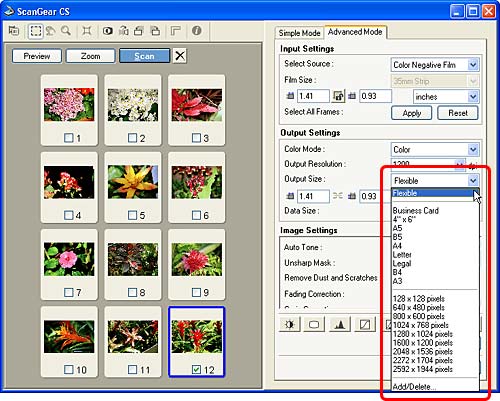
Flexible You can select the Output Resolution and the width, height and scale settings when you select the Flexible option. The default Output Resolution is 1200 dpi and the scale is 100%. Adjust these as required. Paper Format Sizes You can select from the Business Card, 4" x 6", A5, B5, A4, Letter, Legal, B4 and A3 options. The default Output Resolution is 300 dpi. The width, height and scale settings cannot be selected. The scale will automatically change according to the size of the area selected with the cropping frame. Image Display Sizes You can select from the 128 x 128 pixels, 640 x 480 pixels, 800 x 600 pixels, 1024 x 768 pixels, 1280 x 1024 pixels, 1600 x 1200 pixels, 2048 x 1536 pixels, 2272 x 1704 pixels and the 2592 x 1944 pixels options. These dimensions conform to computer display sizes and digital camera output sizes. The default Output Resolution is 150 dpi. The width, height and scale settings cannot be selected. Choosing one of the image display sizes automatically crops the preview image to the corresponding size. The width-to-height aspect ratio will remain unchanged if you enlarge, shrink or move the cropping frame. 
- The Output Resolution can be set individually for any option within the Flexible, paper format sizes and image display sizes categories. The same Output Resolution is used within any one of the three categories.
-
A warning message will display if you set the Output Resolution higher than necessary. If you proceed anyway, it may take an extremely long time to scan and yield a very large image file.
Input Resolution and file sizes vary with the selected Output Resolution and scale settings (35 mm films). Output Resolution
(resolution of the image as passed to an application program)Scale
(magnification setting)Input Resolution
(actual resolution at which an image is scanned)File Size
(rough estimate)300 dpi Approx. 400% 1200 dpi
(300 dpi x 400%)Approx. 6.5 MB 600 dpi Approx. 400% 2400 dpi
(600 dpi x 400%)Approx. 25.9 MB 1200 dpi Approx. 400% 4800 dpi
(1200 dpi x 400%)Approx. 105.7 MB 2400 dpi Approx. 400% 9600 dpi
(2400 dpi x 400%)Approx. 414.7 MB 3200 dpi Approx. 400% 12800 dpi
(3200 dpi x 400%)Approx. 737.3MB The data volumes are shown for BMP and PICT format images. Images saved in compressed file formats, such as the JPEG format, will be smaller.
- Set the other categories as required.
- Click the [Scan] button.
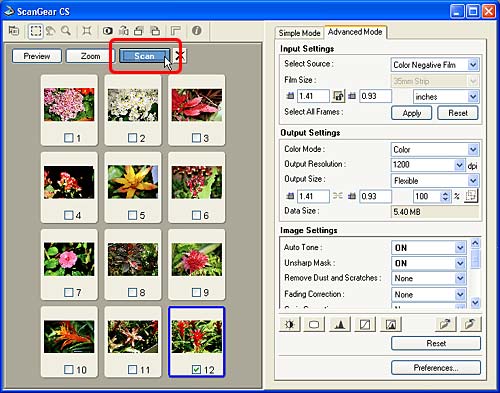
- After the scan is complete, click the close box
 (Windows) or
(Windows) or  (Macintosh) to close ScanGear CS.
(Macintosh) to close ScanGear CS.
The image will display in the application program.
- Save the displayed image.
- After you have finished scanning film, put the protective sheet back on the document cover of the scanner.
 Always replace the protective sheet when you are not scanning film.
Always replace the protective sheet when you are not scanning film.


